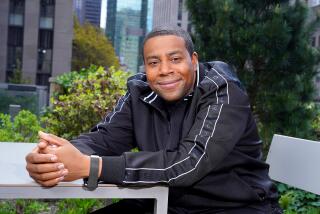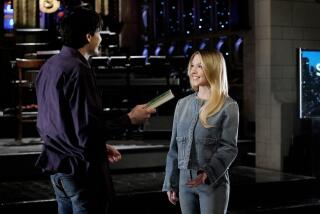Where celebrities dish -- relaxed, uncensored -- for hours
Kevin Pollak’s live online talk show is supposed to run for two hours, but tonight it’s going long again -- way long. That doesn’t bother Pollak: He wants his guest to keep talking.
Between sips of beer, former “Saturday Night Live” star Dana Carvey ranges through a series of strange and revealing anecdotes as Pollak nods from across a round wooden table.
With a glint in his eye, Carvey brings to life an evening two decades ago when he was at a small get-together at the home of “SNL” producer Lorne Michaels. There was a knock on the door and Carvey answered. It was Paul McCartney -- the first person Carvey had taught himself to imitate, when he was 9.
“Your face has gone a bit funny,” Carvey, mimicking McCartney’s Liverpudlian accent, recalls the singer saying.
Carvey goes on, uninterrupted: Several days later, after he and McCartney listen to an unpublished track the music legend had recently recorded, McCartney leans over to Carvey and confides, “Sometimes, when you’re writing, you try to live up to whatever . . . and you end up ruining the [expletive].”
Pollak snorts in disbelief.
“Kevin Pollak’s Chat Show” is streamed on the Internet, and there’s no reason to stop a good interview -- not for time slots, not for commercials and certainly not for censors. The long-format interview show is unlike anything else on the Web or certainly, with its unfiltered conversations, on broadcast television.
The likes of James Lipton and Charlie Rose have been hosting lengthy conversations with celebrities for years. But that was conventional television -- a high-stakes enterprise. Pollak is playing the same game with some big names, but with far fewer rules.
Online -- where Hollywood’s efforts at original programming have floundered and amateur videos have flourished without advertisers -- the pressures of television are blissfully remote. Pollak’s show doesn’t even have salaries to pay.
Indeed, removing TV’s constraints is like taking the conversation out of a corset: Everyone breathes easier and lets a little more hang out. And viewers get a glimpse of what celebrities sound like uninhibited.
In a conversation spiked with cursing, drug references and R-rated banter, Carvey has taken Pollak and the online audience from his childhood through his television and movie career, his 1997 struggle with cardiac problems and a bungled bypass surgery. The finale is Carvey reprising a heart-to-heart chat last October with his onetime satirical target and current friend George H.W. Bush.
In his famous Bush accent, Carvey mimics what the former president confided about the end of his son’s administration: “For us, it’s all about getting our boy back.”
“Oh man,” Pollak says. “Oh man.”
Near the end, Carvey asks Pollak, an old friend from their stand-up comedy days: “How do you do this? It’s like 2 1/2 hours of television. Who does this?”
“Nobody,” Pollak says.
In commercial or critical terms, original Internet television has produced few successes. For most efforts, scoring even a thousand viewers is a coup. Only a few shows have been able to win regular audiences of a million or more -- usually qualified.
“Lonelygirl15,” for example, was a Web hit in 2006, but interest waned when viewers realized the thriller’s ingenue was fictional. Last year’s “Dr. Horrible’s Sing-Along Blog,” starring Neil Patrick Harris, was widely lauded but had only three episodes. A current hit is “Fred,” an amateur show about the life of a hyperactive 6-year-old, which was created by a Nebraska teenager but is largely unknown to adults.
Hollywood has been even less effective online than those independent productions. Web production studios such as Disney’s Stage 9 Digital and Turner Entertainment’s SuperDeluxe were shut down with little fanfare.
Pollak tapes his show from a corner studio -- with exposed ceiling joists -- inside a cavernous, stone-floor Santa Monica factory that is home to Web search company Mahalo.com, his production partner. The makeup and dressing room is a white-tiled industrial shower area. The night Carvey appeared, a few friends of Pollak -- seated in plastic chairs against the wall -- made up the studio audience.
Pollak’s show has aired 12 episodes at kevinpollakschatshow.com at 5 p.m. Sundays. The audience is minuscule compared with, say, the 5.2 million on average who watched Jay Leno’s final season of “The Tonight Show.” The episode with Carvey drew about 400 simultaneous viewers, with about 8,000 surfing by to catch bits before moving on. Many learned about the show through word of mouth and sent chat or Twitter messages to the laptop at Pollak’s side.
Pollak and his production partner said they don’t worry much about the number of people tuning in. The episodes are archived online. They figure that if they can bank enough quality interviews, maybe fans will find the content later, days or months after the taping. Or even buy a DVD.
But for an interview show that few have heard of, Pollak has amassed an impressive guest list. Actors Matthew Perry of “Friends” and Jon Hamm of “Mad Men” have appeared, and this Sunday, director Kevin Smith of “Clerks” and “Chasing Amy” is scheduled. Comedian Adam Carolla did the hourlong segment before Carvey’s.
Pollak also has mixed in figures more recognizable in the world of digital culture: actress Felicia Day, of online comedy series “The Guild,” and Elon Musk, founder of electric car manufacturer Tesla Motors.
Guests seem to be put at ease by Pollak, a veteran of three decades in show business. Besides appearing in dramas such as “A Few Good Men” and “The Usual Suspects,” he is a seasoned comic especially skilled at ad lib and impressions.
In one of the show’s gags, Pollak ridicules Kevin Bacon for “needing” six steps to connect himself to any other celebrity. Pollak repeatedly shows he can do it in three -- or fewer. When a viewer sent a message trying to stump him with Bette Davis, he scoffed, “Nice try.” The one degree was Mia Farrow, who played Pollak’s mother in 1995’s “Miami Rhapsody” and performed alongside Davis in 1978’s “Death on the Nile.”
Being a few degrees away from everyone in show business helps when it’s time to book guests.
“I’ve got a barn and some costumes,” he said he tells guests. “Let’s throw on a [expletive] show!”
There’s that expletive again. Pollak doesn’t bother censoring himself. “The rule from the beginning was this cannot be slick, it cannot be polished,” he said. “It can’t be about any concerns that broadcast television could have.”
Pollak admits to stealing his minimalist leitmotif from the set of PBS talk show host Charlie Rose: a wooden table and a black background. Like Rose, he has thrown out the practice of pre-interviewing guests.
He believes that plotting a discussion’s course in advance leads to the kinds of rigid, plug-filled segments common on late-night television. “When we go on [those] talk shows, it’s not to share our stories -- it never is,” Pollak told Carvey during their conversation. “You’ve got to kill in six minutes, and every second counts.”
Carvey agreed: “I don’t treat going on Letterman or Leno as an interview at all. It’s a complete performance.”
Pollak and Mahalo each own half the show, but so far, that means little in terms of revenue or expenses.
The 23-year-old director and the crew of up to three people are Mahalo employees who volunteer their time. Mahalo already owned the equipment. A bowl of homemade pasta salad on a banquet table suggested that food costs may not be particularly high, either.
“The main reason for doing the show is that the people who are doing it enjoy it,” said Jason Calacanis, Mahalo’s chief executive. “The audience in some ways is secondary.”
But they’re angling for a strategy that would bring in some money. Pollak looks back to the early days of television -- to “The Colgate Comedy Hour” -- when a single brand would provide a show’s support in exchange for constant exposure.
Calacanis said Pollak’s show already has one sponsor, the online video platform Ustream.tv, but he would not disclose the financial terms. He said he hoped Pollak’s efforts would have broader appeal to attract sponsors able to pay “a couple of thousand dollars” each per show.
Among Mahalo’s other productions is “This Week in Startups,” an online program that generates about $2,500 total per show from its three sponsors.
But the partners also have a post-television mentality, judging the success of a show less by what happens the night it airs than by what happens thereafter.
“The archive is the endgame,” Calacanis said.
Viewers of “Kevin Pollak’s Chat Show” can watch the entire catalog of full-length episodes online at any time, or they can download them from iTunes for free. Thousands more viewers have nibbled at archived episodes than have watched live. Eventually, the partners want to package the biographical interviews on DVDs and sell them.
A joke on Pollak’s set is that the show has only 17 loyal viewers. There are more than that, but the small size of the regular online viewership -- and the way Pollak and the crew interact with them as the show is taping -- gives the enterprise a tight-knit feel that wouldn’t be possible on a large scale.
“The word ‘community’ seems to make more sense than ‘audience.’ An audience feels like something you market to,” Pollak said. “A community seems like something that finds you.”






